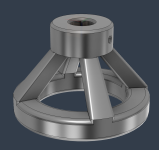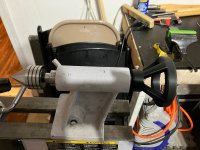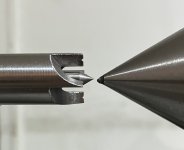Hi all, I'm (kinda) new here, after turning pens for around 17 years, and lurking on this forum for probably something like a decade.
I come hat in hand looking for help from people who know their way around a lathe. I'm pretty comfortable using one, but I've never had occasion to this point to try and fix one.
When I was but a lad, at the tender age of 15, I took a shop class at my Jr. High and fell in love with making pens. After much pleading, my dad bought a wood lathe that summer - a Delta Midi Lathe (Model LA200 type 1). This would have been circa ~2006. I probably made a hundred pens on that lathe over the next few years.
Fast forward past me moving out of the house, college, getting married, 2 kids, buying my first house... etc. Somewhere in there my dad upgraded to a newer lathe (I definitely got him hooked on woodworking and now he has a rather nice shop). The trusty LA200 was sold to someone else, passed through some non-zero number of additional owners, and... as luck would have it, I got in contact with the latest owner of it last week. He had upgraded and wanted to get rid of it, and I just so happened to have cleared some space in my garage for it. I picked it up a couple of nights ago, and it was like being reunited with an old friend.
Well. An old friend who has survived 10+ years of neglect and possibly abuse.
So before we proceed, I'll just get it out of the way. Restoring this old lathe is going to be more time and effort and $ than makes sense. I would be better off buying a new lathe. But I don't want to. It has sentimental value.
This site has been pretty helpful for me so far, at least in confirming to me that 95% of the parts for this lathe are long since discontinued and unobtanium, even on eBay.
On the rather long of things I need to fix is the headstock. It spins in about a 1/32" circle around the tailstock, the hand wheel gets really hot when it's running (I suspect due to the belt pulleys being misaligned on the spindle and rubbing weirdly on the housing), and the bearings sound like 'nam.
Parts #6 and #30 from that site above appear to be the bearings I need to replace. First off, is it strange that they're two different bearings? I would have expected them to match. Secondly, the discerning investigator will have noticed that one of the bearings is apparently a popular one for all sorts of machinery, so it's right there ready to order for $25. Cool. The other is obsolete and unavailable.
Am I crazy in thinking that there's no reason Delta's design team would have ignored the 232847 available standard sized bearings in favor of manufacturing a proprietary one in-house for this use case? Once I get these bearings out, could it simply be a matter of measuring the outer and inner diameters, and thickness, and finding a standard sized bearing of the same dimensions that is rated for the type of rigor these ones are subjected to?
Any opinions welcome here.
Edit: I should mention that I really don't think the lathe is a lost cause. Even with the litany of issues, I was able to turn a pen on it yesterday that came out quite nicely.

I come hat in hand looking for help from people who know their way around a lathe. I'm pretty comfortable using one, but I've never had occasion to this point to try and fix one.
When I was but a lad, at the tender age of 15, I took a shop class at my Jr. High and fell in love with making pens. After much pleading, my dad bought a wood lathe that summer - a Delta Midi Lathe (Model LA200 type 1). This would have been circa ~2006. I probably made a hundred pens on that lathe over the next few years.
Fast forward past me moving out of the house, college, getting married, 2 kids, buying my first house... etc. Somewhere in there my dad upgraded to a newer lathe (I definitely got him hooked on woodworking and now he has a rather nice shop). The trusty LA200 was sold to someone else, passed through some non-zero number of additional owners, and... as luck would have it, I got in contact with the latest owner of it last week. He had upgraded and wanted to get rid of it, and I just so happened to have cleared some space in my garage for it. I picked it up a couple of nights ago, and it was like being reunited with an old friend.
Well. An old friend who has survived 10+ years of neglect and possibly abuse.
So before we proceed, I'll just get it out of the way. Restoring this old lathe is going to be more time and effort and $ than makes sense. I would be better off buying a new lathe. But I don't want to. It has sentimental value.
This site has been pretty helpful for me so far, at least in confirming to me that 95% of the parts for this lathe are long since discontinued and unobtanium, even on eBay.
On the rather long of things I need to fix is the headstock. It spins in about a 1/32" circle around the tailstock, the hand wheel gets really hot when it's running (I suspect due to the belt pulleys being misaligned on the spindle and rubbing weirdly on the housing), and the bearings sound like 'nam.
Parts #6 and #30 from that site above appear to be the bearings I need to replace. First off, is it strange that they're two different bearings? I would have expected them to match. Secondly, the discerning investigator will have noticed that one of the bearings is apparently a popular one for all sorts of machinery, so it's right there ready to order for $25. Cool. The other is obsolete and unavailable.
Am I crazy in thinking that there's no reason Delta's design team would have ignored the 232847 available standard sized bearings in favor of manufacturing a proprietary one in-house for this use case? Once I get these bearings out, could it simply be a matter of measuring the outer and inner diameters, and thickness, and finding a standard sized bearing of the same dimensions that is rated for the type of rigor these ones are subjected to?
Any opinions welcome here.
Edit: I should mention that I really don't think the lathe is a lost cause. Even with the litany of issues, I was able to turn a pen on it yesterday that came out quite nicely.

Last edited:






